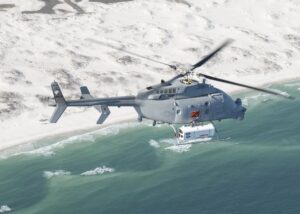The Navy recently demonstrated the prototype Single-system Multi-mission Airborne Mine Detection (SMAMD) System mine countermeasure (MCM) technology aboard an MQ-8C Fire Scout unmanned aircraft.
The SMAMD demonstration was used on an MQ-8C flying out of Eglin Air Force Base, Fla., seeking to gather performance data for the Fire Scout and SMAMD system to inform future MCM integration efforts. On July 7 the service announced this testing occurred in May.
SMAMD was developed by
BAE Systems under a Future Naval Capability program sponsored by the Office of Naval Research (ONR). According to a Navy statement, the system is an airborne optical sensor suite that seeks to detect and localize mines and obstacles on land and at sea in a single pass.

SMAMD provides real-time detection of mines via data link, which would allow warfighters to respond to threats faster than current technologies that require post-mission analysis. The Navy said SMAMD notably has a low false-alarm rate.
The experimenting team conducted operations from the Naval Surface Warfare Center using drifting, tethered, and moored mines from the beach zone to deep waters. They gathered data during the day, night, across all water depths and in mild to difficult weather conditions.
The service argued this demonstration proved the MQ-8C is reliable with repeatable high performance.
“The air vehicle handled the dual podded system with ease, being the first MCM capability flown on the MQ-8C as well as the heaviest payload carried to date. Fire Scout successfully operated in restricted and unrestricted air space alongside other aircraft platforms,” the Navy said.
ONR led this experimentation effort with support from the Navy’s MQ-8 Fire Scout program office, the Program Executive Office Unmanned and Small Combatants (PEO USC), Naval Air Warfare Center Aircraft Division (NAWCAD), Aircraft Prototype Systems Division (APSD), Webster Outlying Field (WOLF), the Digital Analytics Infrastructure and Technology Advancement Group Prototyping, Instrumentation and Experimentation Department, and Air Test and Evaluation Squadron Two Four (UX-24).
The Navy said ONR and PMA-266 worked with NAWCAD AIRWorks to manage the demonstration to use AIRWorks’ project execution expertise and ability to connect warfare center resources.
“The AIRWorks SMAMD Team was proud to be a part of demonstrating a future naval capability, which provides real-time threat detection to the warfighter. Through this effort, we were able to assist in risk reduction and provide critical data for future integration,” AIRWorks’ Project Lead Kristina Hewitt-Thompson said in a statement.
AIRWorks is NAWCAD’s office dedicated to delivering fast and affordable solutions to meet immediate and emergent warfighter needs focused on aircraft modification, prototype, additive manufacturing, system integration, sustainment, and rapid contracting.
The Navy underscored the team executed this complex demonstration in under 24 months. The process included airworthiness and certification tests, design, fabrication and hardware integration with stakeholder organizations and the Air Force.
“The team successfully demonstrated that the prototype SMAMD System effectively operates as designed aboard the MQ-8C Fire Scout unmanned helicopter in relevant real world environments. This cutting-edge technology could really enhance Fire Scout’s capability going forward,” Capt. Thomas Lansley, Fire Scout program director, said in a statement.